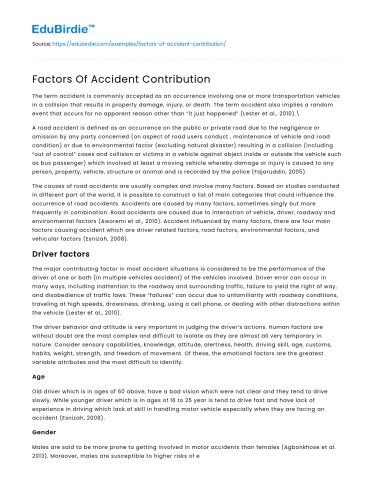The term accident is commonly accepted as an occurrence involving one or more transportation vehicles in a collision that results in property damage, injury, or death. The term accident also implies a random event that occurs for no apparent reason other than “it just happened” (Lester et al., 2010).\
A road accident is defined as an occurrence on the public or private road due to the negligence or omission by any party concerned (on aspect of road users conduct , maintenance of vehicle and road condition) or due to environmental factor (excluding natural disaster) resulting in a collision (including “out of control” cases and collision or victims in a vehicle against object inside or outside the vehicle such as bus passenger) which involved at least a moving vehicle whereby damage or injury is caused to any person, property, vehicle, structure or animal and is recorded by the police (Fajaruddin, 2005).
Save your time!
We can take care of your essay
- Proper editing and formatting
- Free revision, title page, and bibliography
- Flexible prices and money-back guarantee
The causes of road accidents are usually complex and involve many factors. Based on studies conducted in different part of the world, it is possible to construct a list of main categories that could influence the occurrence of road accidents. Accidents are caused by many factors, sometimes singly but more frequently in combination. Road accidents are caused due to interaction of vehicle, driver, roadway and environmental factors (Aworemi et al., 2010). Accident influenced by many factors, there are four main factors causing accident which are driver related factors, road factors, environmental factors, and vehicular factors (Esnizah, 2008).
Driver factors
The major contributing factor in most accident situations is considered to be the performance of the driver of one or both (in multiple vehicles accident) of the vehicles involved. Driver error can occur in many ways, including inattention to the roadway and surrounding traffic, failure to yield the right of way, and disobedience of traffic laws. These “failures” can occur due to unfamiliarity with roadway conditions, traveling at high speeds, drowsiness, drinking, using a cell phone, or dealing with other distractions within the vehicle (Lester et al., 2010).
The driver behavior and attitude is very important in judging the driver’s actions. Human factors are without doubt are the most complex and difficult to isolate as they are almost all very temporary in nature. Consider sensory capabilities, knowledge, attitude, alertness, health, driving skill, age, customs, habits, weight, strength, and freedom of movement. Of these, the emotional factors are the greatest variable attributes and the most difficult to identify.
Age
Old driver which is in ages of 60 above, have a bad vision which were not clear and they tend to drive slowly. While younger driver which is in ages of 16 to 25 year is tend to drive fast and have lack of experience in driving which lack of skill in handling motor vehicle especially when they are facing an accident (Esnizah, 2008).
Gender
Males are said to be more prone to getting involved in motor accidents than females (Agbonkhose et al. 2013). Moreover, males are susceptible to higher risks of experiencing fatal crashes yet their female counterparts are largely involved in higher rates of injury crashes. A possible reason for this is that males are traditionally exposed to traffic risks due to the belief that driving as a profession is mostly dominated by men or due to their involvement in various activities such as travelling to work and social hubs such as beerhalls/ pubs (Al-Haji, 2005; Agbonkhose et al. 2013). However, this trend is changing as more females now take part in previously male dominated activities increasing their exposure to traffic risks (Al-Haji, 2005).
Healthy Conditions
Some medical conditions are also cited to be risk factors for driving. For example, diabetes and epilepsy have been identified as factors that are associated with increased risk if a person is allowed to drive (Bekibele et al. 2007). Hermans et al. (2008) and EU-OSHA (2010) point out that a number of common medications and acute psychological stress influence driving capacity by lowering concentration levels, alertness and reaction rate thus increasing the probability of accident occurrence and injury severity rates. In addition, under normal circumstances people visit the doctor when they have health issues. However, long distance drivers ignore their health problems and drive with headaches and other impairments or take self-help medication from counters to relieve pain as they do not have sufficient time to see the doctor (Peden et al. 2004; EU-OSHA, 2010). As a result, they put themselves at risk of being involved in an accident and affecting other road users.






 Stuck on your essay?
Stuck on your essay?

